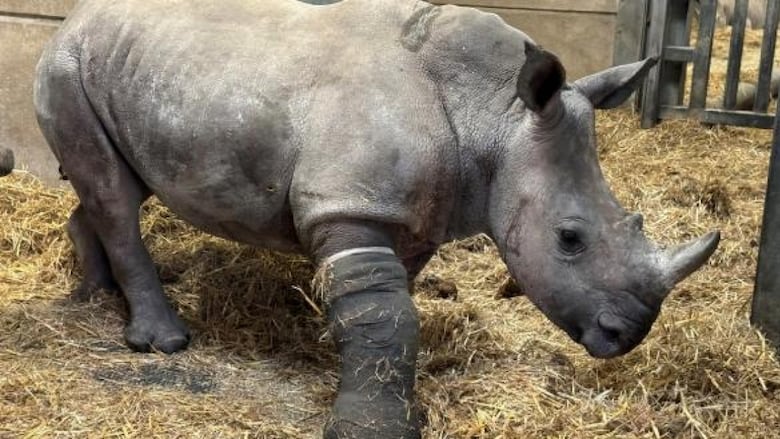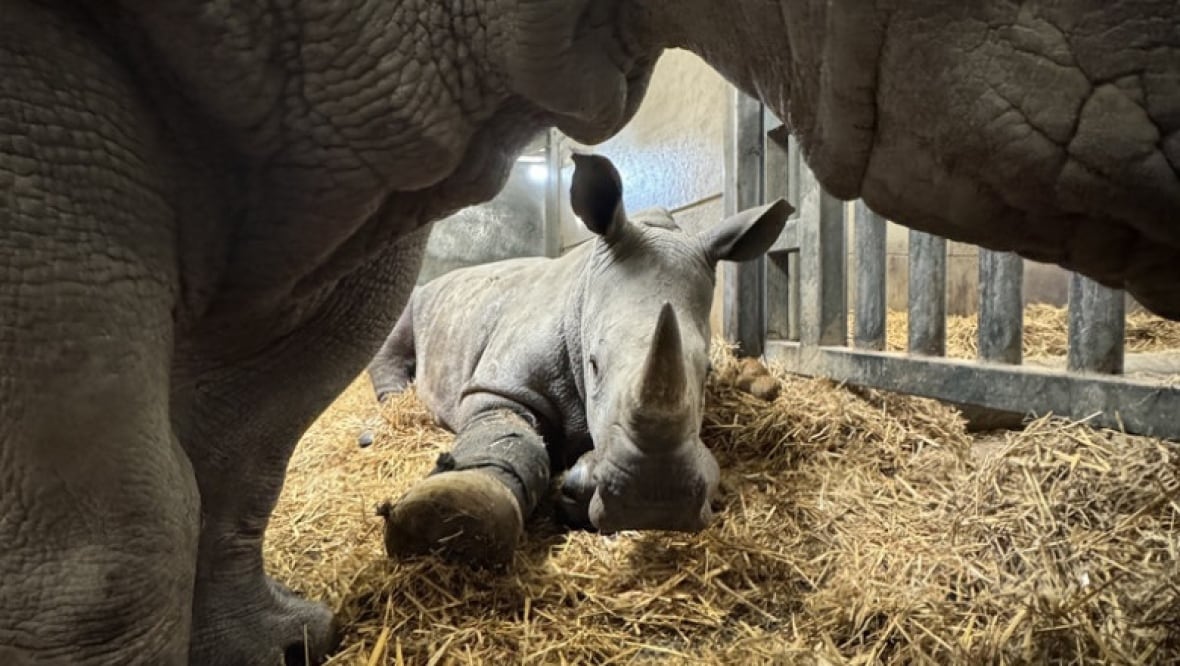What do you do when a rhino breaks a leg? Call a horse doctor, of course
When Amara the white rhino suffered a fracture, her keepers weren’t sure what to do


Dr. David Stack sometimes can't believe that just six months ago, he performed what's believed to be a first-of-its kind leg surgery on a rhinoceros.
Stack, a veterinary surgeon, led the team that conducted keyhole surgery to repair a white rhino's fractured leg near Liverpool, England.
"Myself and my wife were driving about two weeks ago and, just suddenly, the penny dropped, and I went: 'How did we do that? That was crazy,"' the veterinary surgeon told As It Happens host Nil Köksal.
The reason it's so mind-boggling is that, as far as he's aware, nobody has ever done this kind of procedure before.
And also, because he's a horse doctor.
'A boisterous youngster'
Stack is a senior lecturer in equine surgery at the University of Liverpool. He's also the husband of a conservation scientist and welfare consultant at Knowsley Safari, a zoo in Prescot, England.
So when Amara the notoriously playful two-year-old rhino hurt her leg during a round of roughhousing with another rhinoceros, he was among the first to know about it.
"She's quite a boisterous youngster and used to — well, still does — like getting herself into trouble," Stack said.

When staff at Knowsley saw how serious Amara's injury was, they contacted the university for help with diagnostics.
"We're kind of used to being thrown curveballs in the hospital," Stack said, adding they've also worked with cattle, alpacas, sheep and goats. "We tend to say yes."
The team administered X-rays on Amara and found a nasty fracture on part of her front leg that Stack describes as the "anatomical equivalent of her wrist."
A piece of bone about "the size of a walnut" had broken off and was lodged in her joint, he said, causing huge amounts of swelling.
"Once we had identified this fracture, the real challenge then was how do we manage this?" Stack said. "These things became complicated because, you know, we couldn't find anybody really, who had had experience treating anything like it."
Breaking new ground
Staff from the university and the zoo pored through the available medical literature, and found no examples of a rhino with this particular injury.
So they read everything they could about rhino surgery, consulted with a vet in South Africa who works with rhinos, and created a game plan.
They converted Amara's enclosure into an operation room, and kept her under heavy anesthesia during the five-hour procedure.

One of the first obstacles, Stack says, was inserting the camera.
"With a horse, we can feel where the joint is and just make a small incision and pop the camera in," he said. "Rhino skin is so thick, really we couldn't .. feel where the joint margins were. So that was certainly a challenge."
They ultimately decided to use an ultrasound to locate the joint.
"We had never done ultrasound scanning on rhinos before. We weren't sure if we could get a picture through their very thick skin," he said. "But thankfully, as it turns out, their skin is quite amenable to ultrasound imaging."
Using the ultrasound as a guide, the team removed the piece of broken bone. Then they had to do something else they'd never done before: put a rhinoceros in a cast.
"She had a cast on for four weeks, which she tolerated like a champ because it's not easy. It totally restricted her movements," Stark said.
Doing much better
Six months later, Amara is doing well.
"This is a major milestone in animal care, and we're beyond thrilled to see Amara and Mum back on the Safari Drive," Knowsley Safari said on Instagram.
When Stack visited Amara on Thursday morning, he says she was lazing about happily and enjoying the warm weather.
He and his colleagues are now writing a case study about the procedure and recovery, so that if something like this happens again, veterinarians will have a road map.
Southern white rhinos like Amara are listed as a near threatened species by the International Union for Conservation of Nature. There are just over 10,000 living in the wild worldwide, and despite major strides in conservation efforts, their populations are decreasing.
"It's a real sense of satisfaction to see her doing well," Stack said.
"Maybe if she continues to rehabilitate, well, she'll go on and become a productive member, you know, adding to the rhino population, when she has babies of her own. So that's something to be proud of."
Interview with David Stack produced by Kevin Robertson
